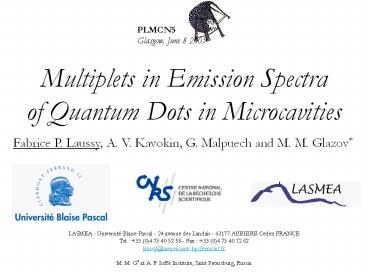Multiplets in Emission Spectra of Quantum Dots in Microcavities - PowerPoint PPT Presentation
Title:
Multiplets in Emission Spectra of Quantum Dots in Microcavities
Description:
Multiplets in Emission Spectra. of Quantum Dots in Microcavities ... LASMEA - Universit Blaise Pascal - 24 avenue des Landais - 63177 AUBIERE Cedex FRANCE ... – PowerPoint PPT presentation
Number of Views:85
Avg rating:3.0/5.0
Title: Multiplets in Emission Spectra of Quantum Dots in Microcavities
1
Multiplets in Emission Spectraof Quantum Dots in
Microcavities
PLMCN5 Glasgow, June 8 2005
Fabrice P. Laussy, A. V. Kavokin, G. Malpuech and
M. M. Glazov
LASMEA - Université Blaise Pascal - 24 avenue des
Landais - 63177 AUBIERE Cedex FRANCETel 33
(0)4 73 40 52 58 - Fax 33 (0)4 73 40 72
62 laussy_at_lasmea.univ-bpclermont.fr M. M. G at
A. F. Ioffe Institute, Saint Petersburg, Russia
2
QDs in Microcavities
From Sheffields group
3
Limitation of the Number of Excitations in the Dot
The premise is simple,
If
This raises the following questions
- What is the exact underlying mechanism for this
effect? - What is the mathematical structure of this
? - Which physics results from this assumption?
4
What is the exact underlying mechanismfor this
effect?
Pauli Principle
The ground state wavefunction
as a function of the single exciton wavefunction
can vanish.
5
What is the mathematical structure of this ?
We define
and
where
We have shown that
6
What is the mathematical structure of this ?
The norm
can be computed exactly
as a function of
With the knowledge of the norm,
We now know an as their successive ratio.
For instance, if b2 1,
since b11,
7
Various cases of Interest
8
Which physics results from this assumption?
Multiplets
THO
Dicke
9
Which physics results from this assumption?
Multiplets
THO
Dicke
10
(No Transcript)
11
(No Transcript)
12
(No Transcript)
13
ConclusionsPerspectives
14
In this work,
- We have presented a model for excitations in
large QDs which interpolate between the fermionic
and bosonic limits, predicting a saturation due
to Pauli Blocking. - We have investigated the strong coupling of a
single radiation mode with these excitations in
two limiting cases, the THO and the Dicke case. - In the limit of small saturation number, we
predicted a multiplet structure qualitatively the
same for all models. - In the limit of large saturation number, each
model acquires specificites of its own (Dicke
forks, etc)

